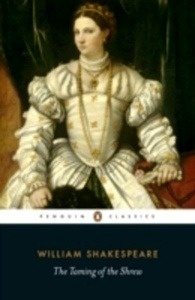The Taming of the Shrew

Editorial Penguin UK
Fecha de edición septiembre 2015 · Edición nº 1
Idioma inglés
EAN 9780141396583
Libro
encuadernado en tapa blanda
Resumen del libro
A relentlessly witty battle of the sexes, William Shakespeare's comedy The Taming of the Shrew is edited by G.R. Hibbard, with an introduction by Margaret Jane Kidnie in Penguin Shakespeare. The beautiful but sharp-tongued 'shrew' Katherina has sworn never to accept the demands of any would-be husband.
Her younger sister Bianca, meanwhile, is forbidden to be married until Katherina finds a suitable match - much to the dismay of Bianca's suitors, Hortensio and Gremio. But when Katherina is pursued by the wily Petruchio, it seems that she has finally met her match. And as he meets her own caustic words with a feigned, capricious cruelty, Katherina quickly comes to understand the absurdity of her shrewish behaviour, in one of the greatest of all comic conquests.
Famously adapted into Cole Porter's musical Kiss Me, Kate and filmed as 10 Things I Hate About You with Heath Ledger and Julia Stiles, The Taming of the Shrew is an unforgettable battle of wits. This book contains a general introduction to Shakespeare's life and Elizabethan theatre, a separate introduction to The Taming of the Shrew, a chronology, suggestions for further reading, an essay discussing performance options on both stage and screen, and a commentary. William Shakespeare (1564-1616) was born to John Shakespeare and Mary Arden in late April 1564 in Stratford-upon-Avon.
He wrote about 38 plays (the precise number is uncertain), many of which are regarded as the most exceptional works of drama ever produced, including Romeo and Juliet (1595), Henry V (1599), Hamlet (1601), Othello (1604), King Lear (1606) and Macbeth (1606), as well as a collection of 154 sonnets, which number among the most profound and influential love poetry in English. If you enjoyed The Taming of the Shrew, you might like Love's Labour's Lost, also available in Penguin Shakespeare. "I pity the man who cannot enjoy Shakespeare".
Biografía del autor
William Shakespeare fue un dramaturgo y poeta inglés, considerado uno de los más grandes escritores de todos los tiempos. Hijo de un comerciante de lanas, se casó muy joven con una mujer mayor que él, Anne Hathaway. Se trasladó a Londres, donde adquirió fama y popularidad en su trabajo; primero bajo la protección del conde de Southampton, y más adelante en la compañía de teatro de la que él mismo fue copropietario, Lord Chamberlain's Men, que más tarde se llamó King's Men, cuando Jacobo I la tomó bajo su mecenazgo. Su obra es un compendio de los sentimientos, el dolor y las ambiciones del alma humana, donde destaca la fantasía y el sentido poético de sus comedias, y el detalle realista y el tratamiento de los personajes en sus grandes tragedias. De entre sus títulos destacan Hamlet, Romeo y Julieta, Otelo, El rey Lear, El sueño de una noche de verano, Antonio y Cleopatra, Julio César y La tempestad.Shakespeare ocupa una posición única en el mundo, pues sus obras siguen siendo leídas e interpretadas en todo el mundo.








